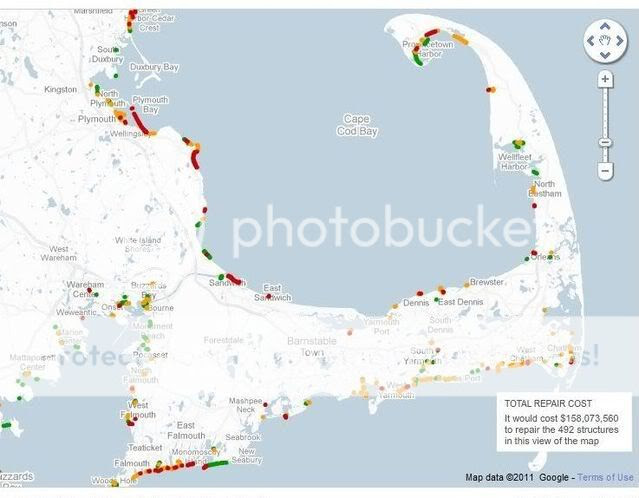(Editor's Note: This article is from about 5 years ago, we diggin' in the crates...)

The Boston Globe and Google Maps are doing a cool service with this map of Massachusetts seawall conditions. Clicking on the individual areas lists the location and repair costs. Every seawall pictured on that map would cost $160 million to repair.
You can see the real thing here at the Globe, but I took the liberty of pasting a few shots of local areas for educational purposes only.
The map shows who has seawalls. The color code is basically Green meaning high quality,Orange meaning poor and Red being critical/non-existent.
The Outer Cape has her own seawall, that being a mountain of dunes. They were what Massachusetts defended herself with before the people era. Anyhow, that's why there are no seawalls of any note on the outer Cape.
They didn't have any info on Nantucket and Martha's Vineyard. I'm sure there are some localized seawalls, at least.
Note that the lower Cape seawall system is designed to stop hurricanes, while the South Shore's is designed to stop nor'easters. That's not 100% exclusive, but it's a good rule of thumb.
Falmouth is heavily sea-walled, and another strip runs off and on from Yarmouth to Chatham.
Seawall repairs are costly. Provincetown alone needs $5 million in seawall repairs. We're coastal people, and we have coastal problems. Things will only get worse if that global warming/sea level stuff is true.
Barnstable is very much unprotected by seawall, so they at least may get to dodge some of this Cost Bullet. They may be penny-wise and pound-foolish, but time will tell.
I'm no expert on the Cape's specific coastal areas, so I'll leave it to you to draw your own conclusions. If you have your own observations, leave them in the comments section.
I did some zooming, and isolated the two wall-iest areas of Cape Cod.... Here's one of them, the Falmouth/Bourne/Sandwich/Onset area. Everything on the map below would cost about $50 million to repair.
Falmouth is obviously prone to terrible tides, and the extensive seawall construction speaks volumes. The areas of Bourne and Onset were devastated during Hurricane Bob, right about where that hurtin-for-certain seawall is.

Much of that seawall is in need of repair. Those repairs will be costly. $50 million dollars = costly. Those repairs are small change against what losing miles of beachfront property would mean in taxes and tourism.
Estimates include seawalls, jetties and anything else armoring the coastline.
The run of seawall that goes from Bourne Pond to Jeweler's Road in Falmouth adds up in several increments to equal $3 million in necessary repairs if you throw in the nearby Eel Pond seawall.
The seawall on Ocean Avenue to the Great Pond area of Falmouth needs $3 million in repairs.
Falmouth Heights needs $4 million in seawall repairs.
Lewis Point in Buzzards Bay needs $500,000 in repairs.
Onset is looking at $1.5-2 million in repairs
Here's the Yarmouth-Chatham run... price tag: $36 million or so.

Red River Beach in Harwich to Cockle Cove in Chatham needs $1.5 million in repairs.
Wychmere Harbor needs almost $2 million in seawall repairs, as does West Dennis Beach.
A series of seawall repairs from Parkers River to Beachwood Avenue in Yarmouth will surge well past $2 million.
Town Fish Pier In Chatham needs $500,000.
I'm not sure if the Wampanoags built seawalls. Native Americans tended/tend to be more reasonable than Europeans, and most likely just didn't settle dangerously close to the beaches.
The picture below is my hometown, Duxbury Beach. I'll focus on it because A) I'm very familiar with it, and B) I have some pictures of it. It runs from the Gurnet Road area of Duxbury to Green Harbor.
The seawall shown via the stripes of different colors protects about 1-2000 people, depending on the time of the year. The Southern half is sparsely populated, making up maybe 3-500 of the total figure even in the summer. The seawall repairs will cost well over $6 million, mostly to the north (and some of which is off the map), in Marsh Vegas.

The red area on the map is a football field-sized gap between the Duxbury seawall and the Marshfield seawall. The Globe reported that there was wall there at some point that has disappeared, but no wall has been there since the 1960s. I'll ask around, but no one I know can remember there being seawall there.
The seawalls were put up in the 1950s, during a hurricane run that gave us Edna and Carol. The seawalls allowed coastal development in an area that was devastated during the 1938 Hurricane and the 1954 sisters.
The seawalls suffer from cracks, crumbling, collapse, erosion and other ailments. The seawall shown putting in work at bottom of the article is from this area.
The green area is where I'm from, and the seawall is just a big slab of concrete. It does the job we ask of it. The neighboring orange area was a portion of the wall (near the old Gurnet Inn) that had started to fall forward. The US Army Corps of Engineers is in charge of repairing the wall, and they dumped tons of boulders against it to arrest the Tower Of Pisa act.
The orange wall in more northern Green Harbor is much "taller" (more of it is exposed, where down-beach Duxbury gets a lot of sand washed up against it) than her sister to the south. Almost the whole length of it requires boulders be shoved against it to keep it from tipping forward. The houses are built right up to the seawall in many cases there.
The extreme top/north of the picture features two giant jetties, made out of piles of boulders, that protect Green Harbor.
Regarding the cost of seawalls, the old divorce joke works pretty well.
Why do seawalls cost so much?
 |
| Because they're worth it! |
No comments:
Post a Comment